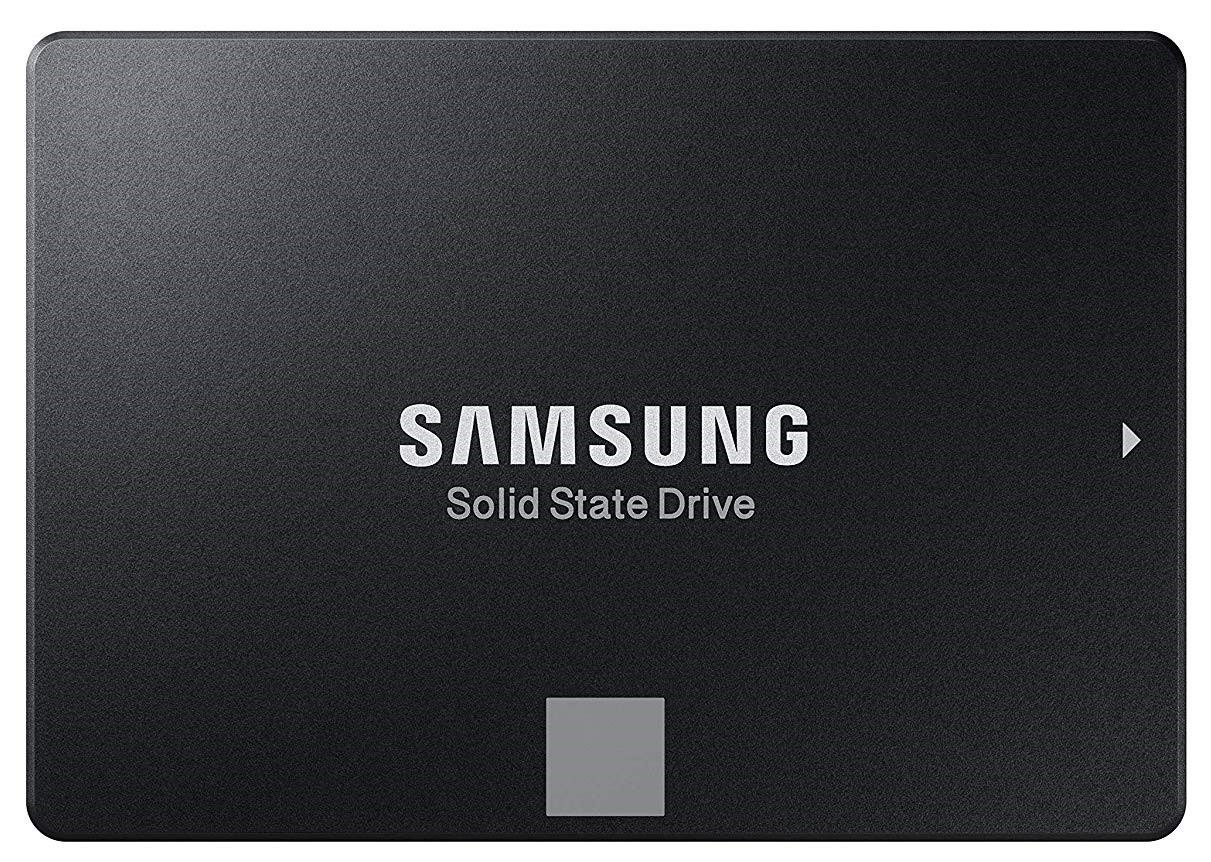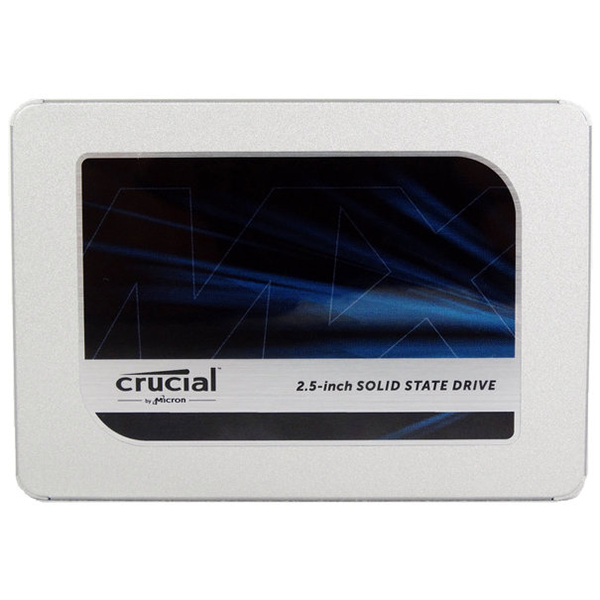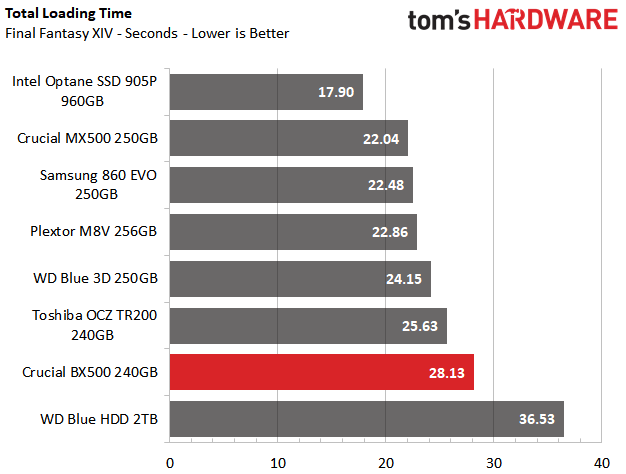Crucial BX500 SSD Review: The DRAMless Invasion Continues (Updated)
Why you can trust Tom's Hardware
240GB Comparison Products
We included the Intel SSD 545s, Samsung 860 EVO, Crucial MX500, Plextor M8V, Toshiba OCZ TR200, and WD Blue 3D as comparisons in this review. All feature 3D TLC flash and current-gen controllers optimized for consumer workloads. We have also added results from a 960GB Intel Optane SSD 905P and a 2TB WD Blue HDD in certain tests.
Trace Testing – PCMark 8 Storage Test 2.0
PCMark 8 is a trace-based benchmark that uses Microsoft Office, Adobe Creative Suite, World of Warcraft, and Battlefield 3 to measure the performance of storage devices in real-world scenarios.
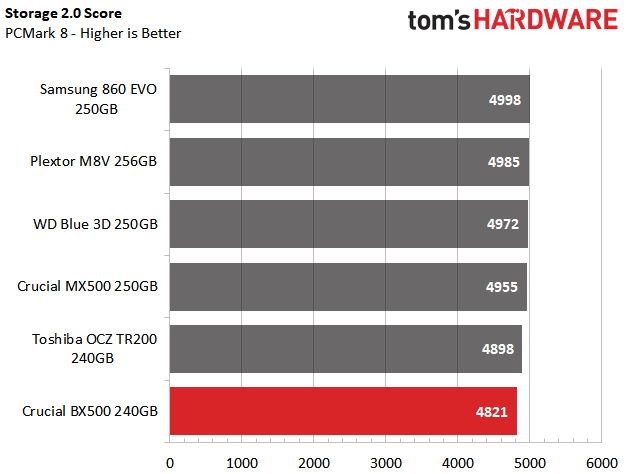

The BX500 has the lowest performance of our comparison pool. As we can see, the DRAMless architecture is a definite weakness in tests that replicate real-world applications that tend to have large datasets.
Game Scene Loading - Final Fantasy XIV
The Final Fantasy XIV StormBlood benchmark is a free real-world game benchmark that easily and accurately compares game load times without the inaccuracy of using a stopwatch.
In this test, most of the top-performing SSDs achieve a total load time of about 22 seconds. The BX500's 28-second load time is better than the HDD, but still much slower than the fastest SSDs.
Transfer Rates – DiskBench
We use the DiskBench storage benchmarking tool to test file transfer performance with our own custom 50GB block of data. Our data set includes 31,227 files of various types, like pictures, PDFs, and videos. We copy the files to a new folder and then follow up with a read test of a newly-written 6GB file.

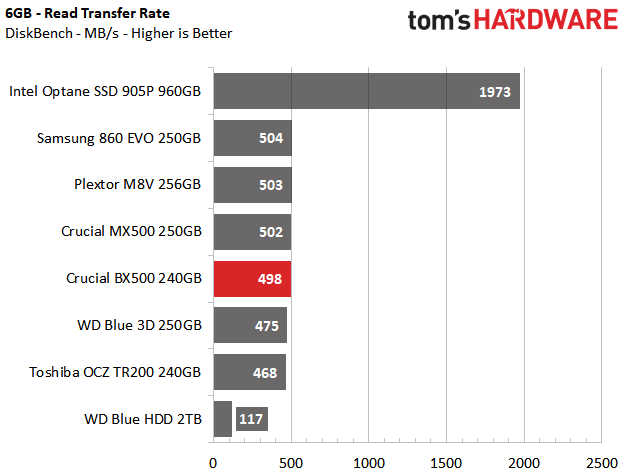
Crucial’s BX500 is unimpressive during our copy test. Again, it falls into last place against the other SSDs. The BX500's average speed of just 68 MB/s is a slim 21 MB/s faster than the HDD. The BX500 averaged 498 MB/s during the read test, which is slightly faster than the WD Blue 3D SSD and a huge advantage over the HDD.
Get Tom's Hardware's best news and in-depth reviews, straight to your inbox.
SYSmark 2014 SE
Like PCMark, SYSmark uses real applications to measure system performance. SYSmark takes things much further, however. It utilizes fourteen different applications to run real workloads with real data sets to measure how overall system performance impacts the user experience. BAPCo's SYSmark 2014 SE installs a full suite of applications for its tests, which includes Microsoft Office, Google Chrome, Corel WinZip, several Adobe software applications, and GIMP. That also makes it a great test to measure the amount of time it takes to install widely-used programs after you install a fresh operating system.
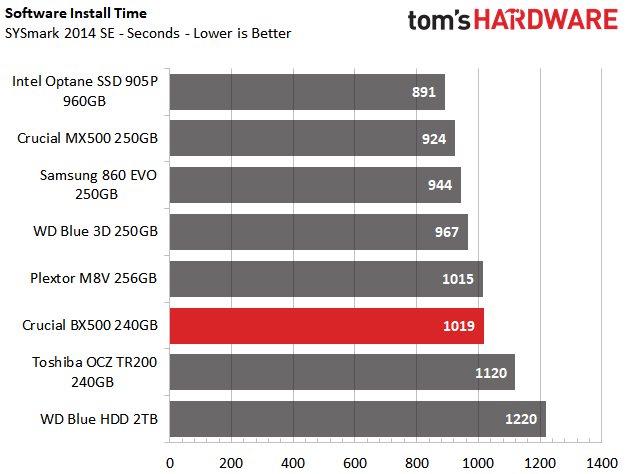
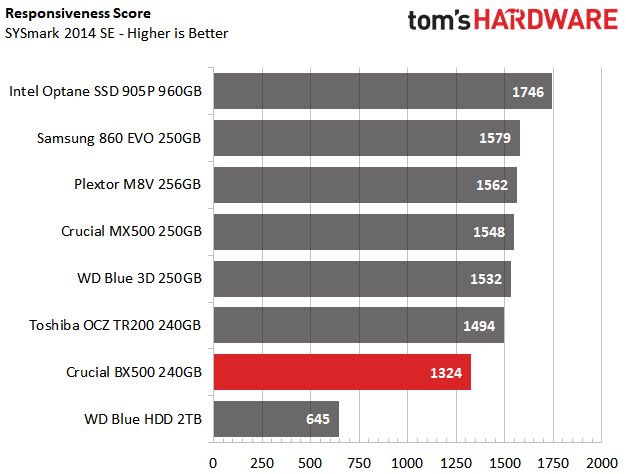
SYSmark installed on the BX500 three and a half minutes faster than it did on the HDD, but it still served up low performance during the application performance tests. The BX500 provided more than twice the performance of the HDD, but it was still the slowest SSD in the test pool.
ATTO
ATTO is a simple and free application that SSD vendors commonly use to assign sequential performance specifications to their products. It also gives us insight into how the device handles different file sizes.

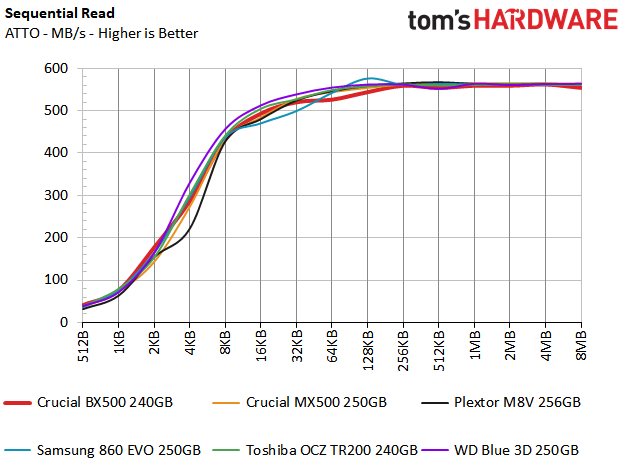
The 240GB BX500 delivers the typical throughput performance we expect out of a SATA SSD. In this test, it matched its 540/500 MB/s of read/write throughput specification.
Anvil's Storage Utilities
Anvil's Storage Utility is a commonly-referenced benchmark that simplifies the complex IOMETER benchmark and its underlying Dynamo engine with a one-click software wrapper.
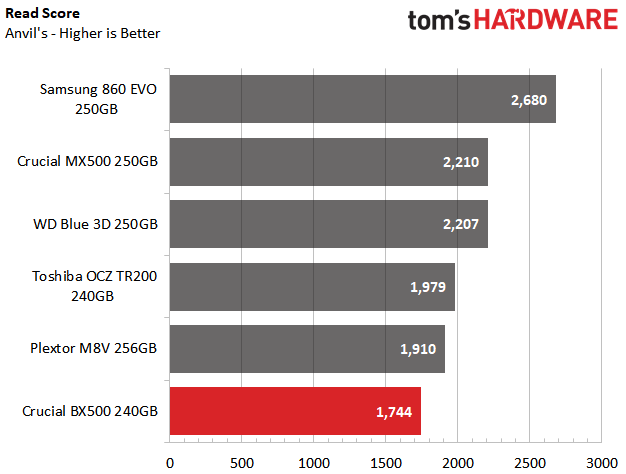
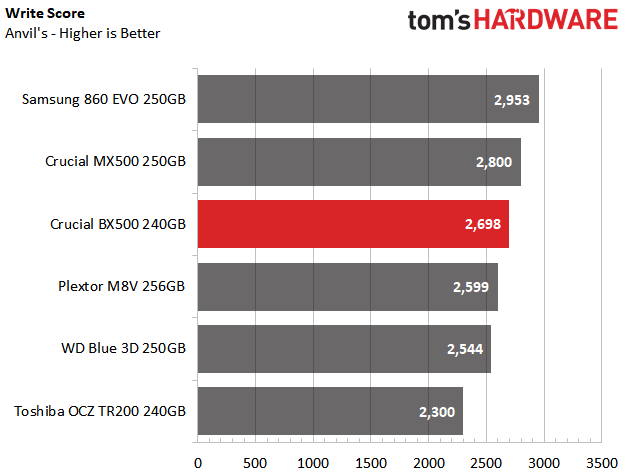

Crucial’s 240GB BX500 achieved a low result during the read test, but it beat the M8V and WD Blue 3D during the write test. The mismatched read and write performance leads to a total score that ranks second to last.
CrystalDiskMark
CrystalDiskMark (CDM) is a simple and easy to use file size benchmarking tool.
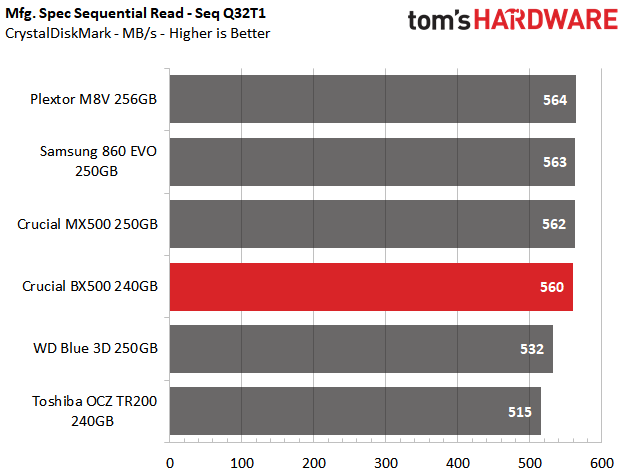

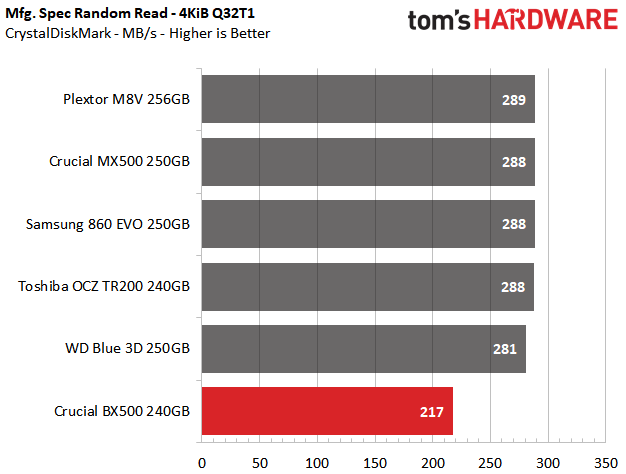

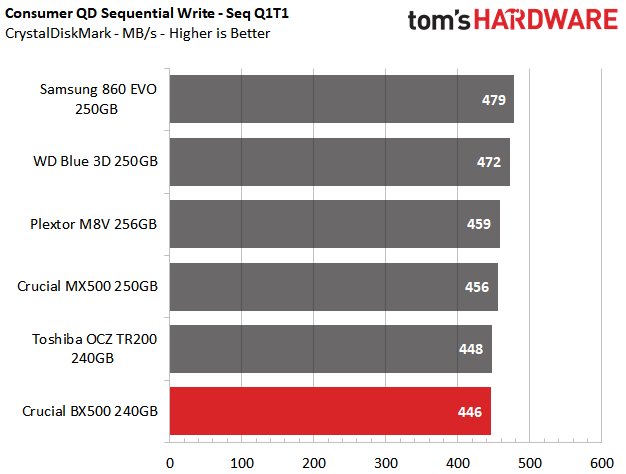
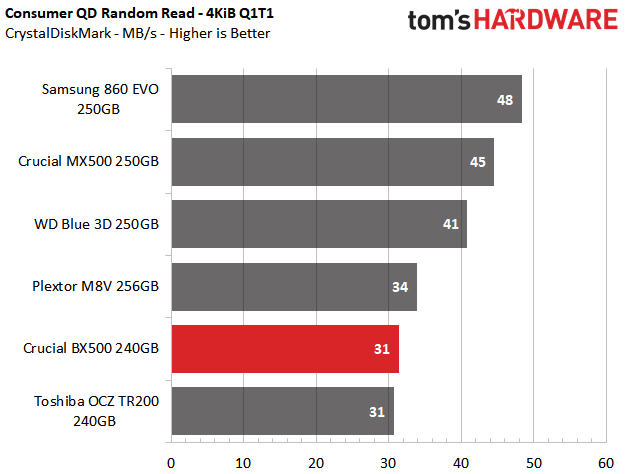
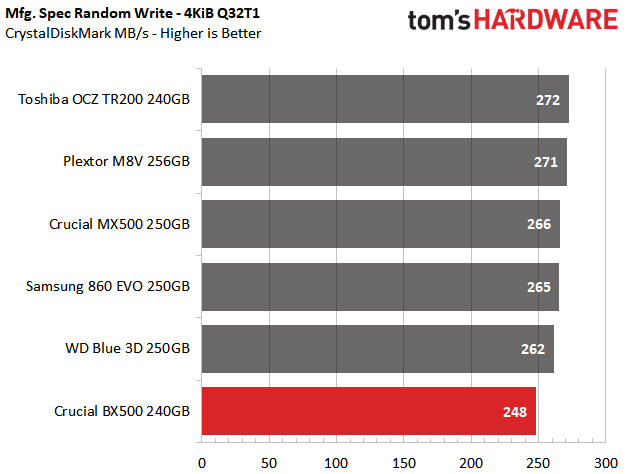

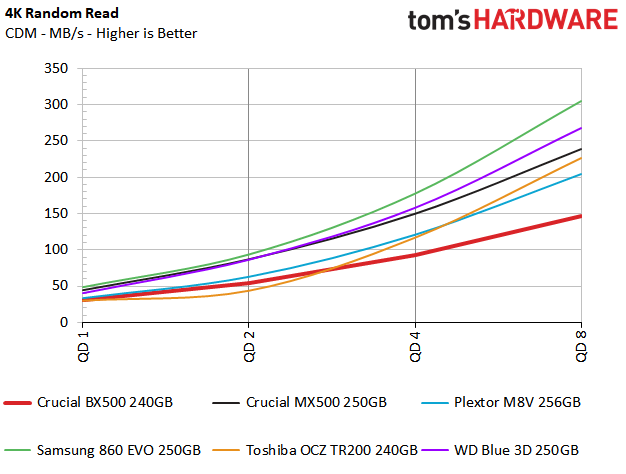

The BX500 reached 560/494 MB/s of peak sequential read/write throughput at QD (queue depth) 32. At a QD of 1, it achieves the second-fastest result during the read test, but again, the lowest result during the write test. The drives' 4K random performance, which is a key measure of snappiness in real-world applications, again proves to be lower than the norm.
Sustained Sequential Write Performance
Official write specifications are only part of the performance picture. Most SSD makers implement an SLC cache buffer, which is a fast area of flash that absorbs incoming data. Sustained write speeds can suffer tremendously once the workload spills outside of the SLC cache and into the "native" TLC or QLC flash. We hammer the SSDs with sequential writes for 15 minutes to measure both the size of the SLC buffer and performance after the buffer is saturated.
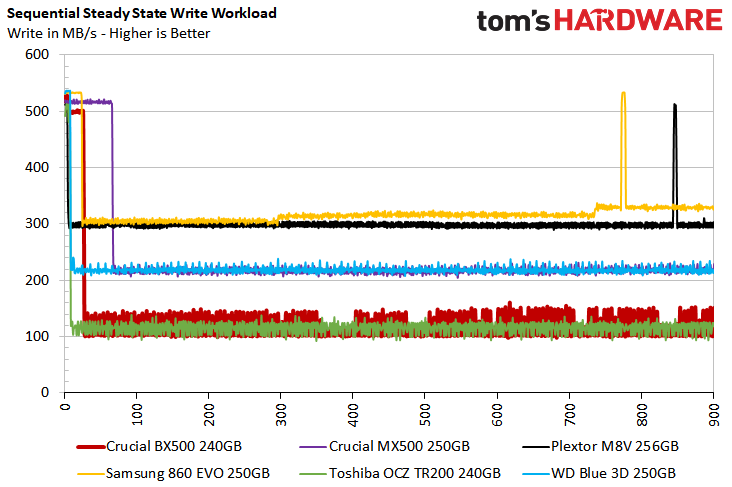
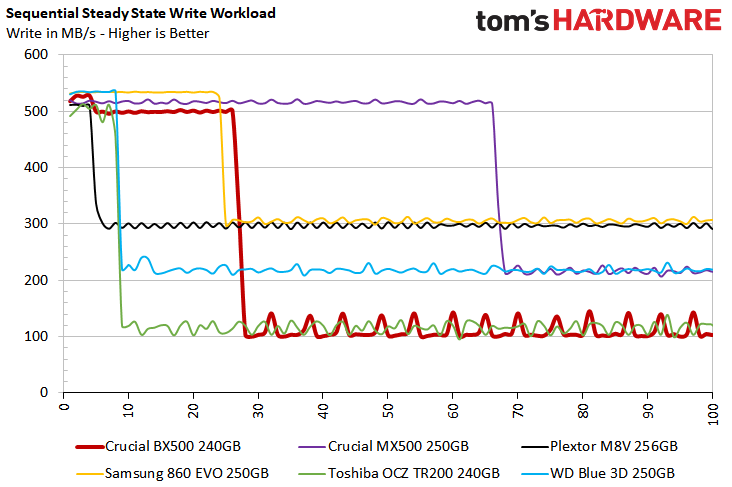
Just like many other SSDs, the BX500 utilizes an SLC cache to absorb small bursts of write traffic. After about 13GB of continuous writes, performance degrades from an average of 500 MB/s to 100 MB/s.
Power Consumption
We use the Quarch HD Programmable Power Module to gain a deeper understanding of power characteristics. Idle power consumption is a very important aspect to consider, especially if you're looking for a new drive for your laptop. Some SSDs can consume watts of power at idle while better-suited one's sip just milliwatts. Average workload power consumption and max consumption are two other aspects of power consumption, but performance-per-watt is more important. A drive might consume more power during any given workload, but accomplishing a task faster allows the drive to drop into an idle state faster, which ultimately saves power.
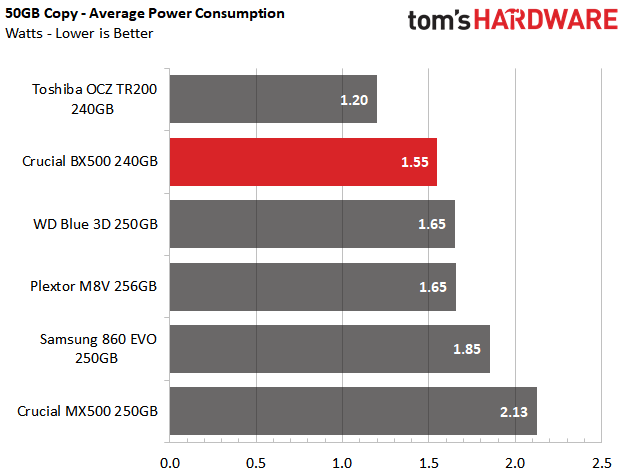

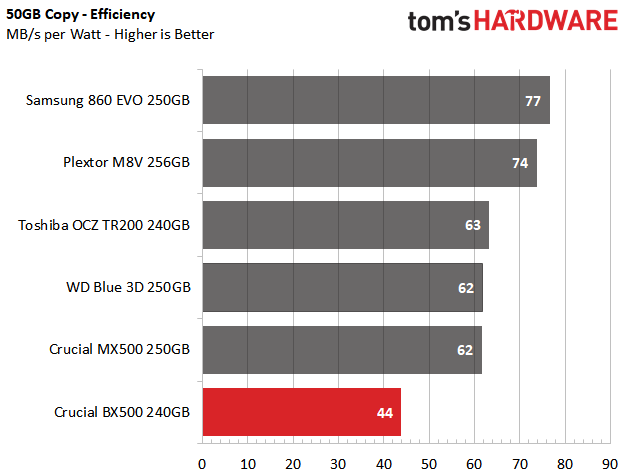

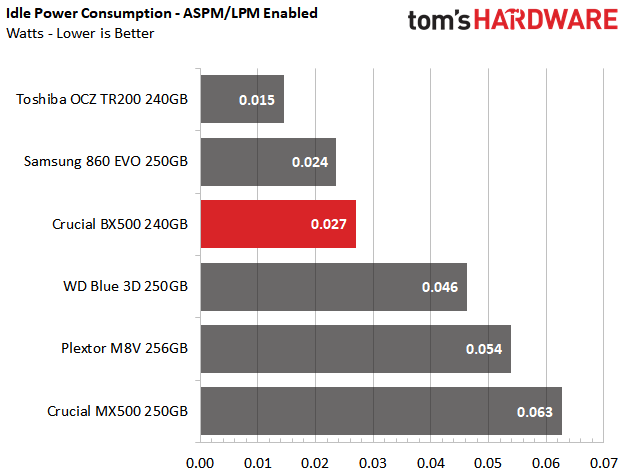
The 240GB BX500 manages its power consumption rather well. It consumes just 27mW with LPM enabled, and 0.4W with the feature disabled. Both results land in third place.
The 240GB BX500 continues to sip power during the file copy test. It averages 1.55W, which is the second lowest result. Crucial’s BX500 may sip power at idle and under load, but that doesn’t mean it is efficient. The BX500's average of 44 MB/s-per-watt lands in last place, which is surprising given the DRAMless architecture.
MORE: Best SSDs
MORE: How We Test HDDs And SSDs
MORE: All SSD Content
Current page: 240GB Performance Results
Prev Page Making SSDs Even Cheaper Next Page 480GB Performance Results
Sean is a Contributing Editor at Tom’s Hardware US, covering storage hardware.
-
logainofhades Doesn't appear to be a great alternative to other drives already on the market. I'd rather spend the extra on an MX500 for the better warranty alone. I use a 1tb MX500, for extra storage, in my laptop. If you can use M.2 NVME, and are on a tight budget, though, the 660p is kind of a no brainer. I have had no complaints, with system performance, with the 1tb, that I have in my desktop.Reply -
chickenballs are you serious? they want 60 bucks for a 500gb dramless ssd?Reply
I just bought a MX500 500gb for 65 dollars...
125 dollars for a 980gb is also laughable when you can get the mx500 1tb for around 140 -
Glock24 Remind me why do DRAMless SSDs exists? You get lower performance, lower endurance and are almost the same price as decent SSDs. I don't see any benefit.Reply -
BaRoMeTrIc Reply
especially when the mx500 is only $5 more on amazon and newegglogainofhades said:Doesn't appear to be a great alternative to other drives already on the market. I'd rather spend the extra on an MX500 for the better warranty alone. I use a 1tb MX500, for extra storage, in my laptop. If you can use M.2 NVME, and are on a tight budget, though, the 660p is kind of a no brainer. I have had no complaints, with system performance, with the 1tb, that I have in my desktop. -
LordConrad Reply
Because there was a bigger price difference when DRAM was expensive.Glock24 said:Remind me why do DRAMless SSDs exists? You get lower performance, lower endurance and are almost the same price as decent SSDs. I don't see any benefit. -
chickenballs lol this is what I call ironyReply
https://www.tomshardware.com/news/crucial-mx500-500gb-ssd-deal-sale,39672.html -
dhivakarag Hi, I am confused between Crucial BX500 960GB (₹6770) vs Intel 660P 1TB (₹9500) as my gaming drive. I use Samsung 970 evo 500GB as my boot drive and I have installed all applications in it except games. Will my game load time decrease if I consider Intel over Crucial? Is Intel worth the price difference and is it reliable as Crucial?Reply -
MoisesLevy75 On the crucial website they report that the SSD has SLC write acceleration. This led us to think that he had NAND SLC memories when he actually has TLC. They has no respect the consumer.Reply
Moises Levy from Osório/RS - Brazil.
